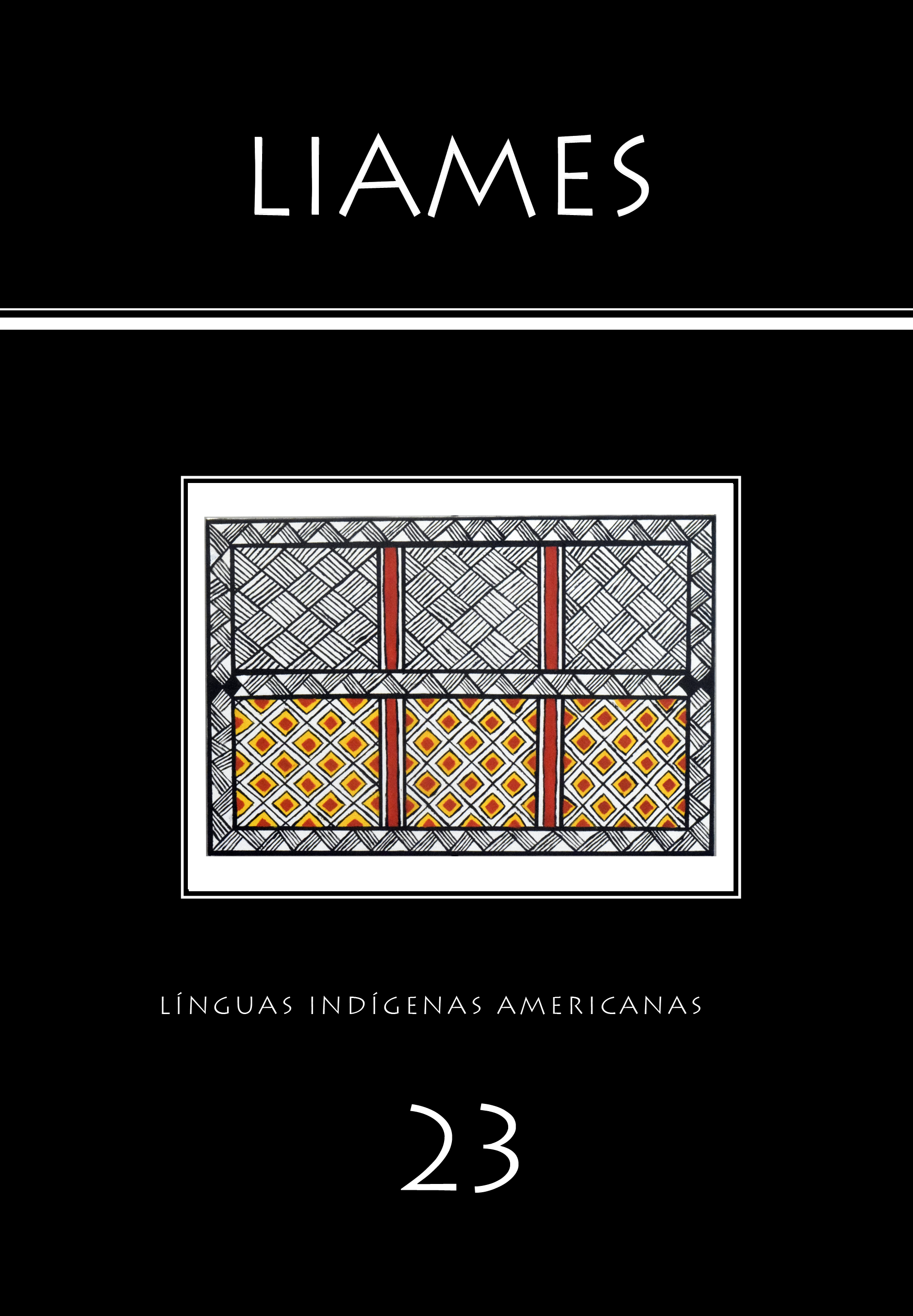Abstract
Ramirez & França’s (2019) claim that a change *a > o took place multiple times and without any discernible conditioning factor - which the authors present as an explicit counterproposal to a series of claims made in Carvalho & Rose (2018) - is methodologically and empirically flawed. We show here that the supposed evidence from loanwords is artifactual, that the comparison between 18th Guaná and modern Terena rests on an arbitrarily selective and, ultimately, misleading treatment of the relevant sources, and that the claimed ancestor-descendant relationship between Old Mojeño and Trinitario is at odds with other well-established claims about the history of Mojeño dialects, in addition to being an unnecessary and extraneous assumption. Moreover, a lexical stratification of the Mojeño lexicon in terms of basic and less-basic strata shows that the main correspondence favored by Ramirez & França (2019) as the reflex of Proto-Arawakan *a in Mojeño is essentially restricted to nonbasic vocabulary, a finding that vindicates Carvalho & Rose’s (2018) interpretation of this pattern as reflecting dialect borrowing or diffusion.
References
Aguirre, Juan Francisco (1793 [1898]). Etnografía del Chaco. Boletín del Instituto Geográfico Argentino XIX: 464-510.
Blevins, Juliette (2004). Evolutionary phonology. New York: Cambridge University Press.
Campbell, Lyle (1996). On sound change and challenges to regularity. In Mark Durie and Malcolm Ross (eds.), The Comparative Method Reviewed, pp. 72-89. Oxford: Oxford University Press.
Campbell, Lyle (1999). Historical linguistics: An introduction. Cambridge MA: MIT Press.
Campbell, Lyle (2018) Language isolates and their history. In Lyle Campbell (ed.), Language Isolates, pp. 1-18. London/New York: Routledge.
Campbell, Lyle and Langacker, Ronald W. (1978). Proto-Aztecan vowels: Part I. International Journal of American Linguistics 44(2): 85-102. https://doi.org/10.1086/465526
Carvalho, Fernando O. de (2016). Terena, Chané, Guaná and Kinikinau are one and the same language: Setting the record straight on southern Arawak linguistic diversity. LIAMES-Línguas Indígenas Americanas 16(1): 39-57. https://doi.org/10.20396/liames.v16i1.8646165
Carvalho, Fernando O. de (2018). The historical phonology of Paunaka (Arawakan). Boletim do Museu Paraense Emilio Goeldi 13(2): 405-428.
Carvalho, Fernando O. de (2021). On the diachronic origins of the accentual contrast in Terena (Arawakan). Transactions of the Philological Society 119(3): 315-329. https://doi.org/10.1111/1467-968X.12220
Carvalho, Fernando O. de and Françoise Rose (2018). Comparative reconstruction of Proto-Mojeño and the phonological diversification of Mojeño dialects. LIAMES-Línguas Indígenas Americanas 18(1): 7-48. https://doi.org/10.20396/liames.v1i1.8648804
Clemente Ferreira, Mário (2011). Fontes cartográficas em arquivos ibero-americanos relativas à fronteira ocidental do Brasil no século XVIII. Revista Eletrônica Documento Monumento 4(1): 35-47.
Danielsen, Swintha (2007) Baure: An Arawak Language of Bolivia. Indigenous Languages of Latin America (ILLA) 6. Leiden: CNWS Publications.
Dolgopolsky, Aharon (1986). A probabilistic hypothesis concerning the oldest relationships among the language families of northern Eurasia. In Vitalij Shevoroshkin and Thomas Markey (eds.), Typology, relationship and time: A collection of papers on language change and relationship by Soviet linguists, pp. 27-50. Karoma: Ann Arbor.
Dworkin, Steven N. (2016). Do Romanists need to reconstruct Proto-Romance? Zeitschrift für romanische Philologie 132 (1): 1-19.
Ekdahl, Muriel and Nancy Butler (comps.) (1969). Terêna dictionary. Arquivo Linguístico 069. Brasília: Summer Institute of Linguistic (SIL).
Gilij, Filippo Salvadore (1780). Saggio di Storia Americana. 4 vols. Rome: L. perego erede Salvioni.
Gill, Wayne (1993). Diccionario Trinitario-Castellano. San Lorenzo de Mojos: Misión Nuevas Tribus.
Greenberg, Joseph H. (1957). The problem of linguistic subgroupings. In Joseph H. Greenberg. Essays in linguistics, pp. 46-55. Chicago & London: The University of Chicago Press.
Hall, Robert E. (1950.) The reconstruction of Proto-Romance. Language 26(1): 6-27.
Hoenigswald, Henry (1973). The comparative method. In Thomas Sebeok (ed.), Current Trends in Linguistics, vol II, pp. 51-62. Diachronic, areal and typological linguistics. The Hague: Mouton.
Holman, Eric; Søren Wichmann; Cecil H. Brown; Viveka Velupillai; André Müller and Dik Bakker (2008). Explorations in automated language classification. Folia Linguistica 42: 331-354. https://doi.org/10.1515/FLIN.2008.331
Joseph, Brian D. (2004). Rescuing traditional (historical) linguistics from grammaticalization theory. In Olga Fisher; Muriel Norde and Harry Perridon (eds.), Up and down the cline - The nature of grammaticalization [Typological Studies in Language 59], pp. 45-71. Amsterdam: John Benjamins. https://doi.org/10.1075/tsl.59.04jos
Kümmel, Martin Joachim (2016). Is ancient old and modern new? Fallacies of attestation and reconstruction. In David Goldstein, Stephanie Jamison and Brent Vine (eds.), Proceedings of the 27th Annual UCL Indo-European Conference, pp. 79-96. Bremen: Hempen.
Labov, William (1994). Principles of linguistic change: Internal factors. Oxford: Blackwell.
Lohr, Marisa (1998). Methods for the genetic classification of languages (Doctoral thesis). University of Cambridge. Available at: https://www.repository.cam.ac.uk/handle/1810/251688
Marbán, Pedro (1702). Arte de la lengua Moxa, con su vocabulario, y cathecismo. Lima: Imprenta Real de Joseph de Contreras. Available at: https://archive.org/details/artedelalenguamo00marb
Olza Zubiri, Jesús; Conchita Nuni de Chapi and Juan Tube (2002). Gramática Moja Ignaciana (Morfosintaxis). Caracas: Universidad Católica Andrés Bello.
Paul, Hermann (1880). Prinzipien der Sprachgeschichte. 2nd edition. Halle: Niemeyer.
Payne, David (1991). A classification of Maipuran (Arawakan) languages based on shared lexical retentions. In Desmond Derbyshire and Geoffrey K. Pullum (eds.), Handbook of Amazonian languages, vol. 3, pp. 355-499. Berlin: Mouton de Gruyter.
Ramirez, Henri (2020). Enciclopédia das línguas arawak. Acrescida de seis novas línguas e dois bancos de dados, 4 vols. Curitiba: Editora CRV.
Ramirez, Henri and Maria C. V. França (2019). Línguas Arawak da Bolívia. LIAMES-Línguas Indígenas Americanas 19: 1-71. https://doi.org/10.20396/liames.v19i0.8655045
Salamanca, Carlos (2015). Saberes geográficos, tensiones de alteridad y teatros del martirio en las cartografías jesuíticas del Nuevo Mundo. Revista Española de Antropología Americana 45(2): 379-401.https://doi.org/10.5209/REAA.54932
Sapir, Edward (1921). Language: An introduction to the study of speech. New York: Dover Publications Inc.
Tadmor, Uri; Haspelmath, Martin and Taylor, Bradley (2010). Borrowability and the notion of basic vocabulary. Diachronica 27(2): 226-246. https://doi.org/10.1075/dia.27.2.04tad

This work is licensed under a Creative Commons Attribution-NonCommercial 4.0 International License.
Copyright (c) 2023 Fernando Orphão de Carvalho


